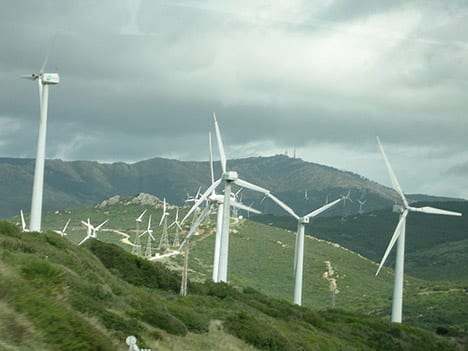 |
| Wind turbines in a Spanish wind farm |
One such site of overlap is Cadiz, Spain, used by griffon vultures (Gyps fulvus) as both a breeding area and a spot from which to launch migration into Africa each fall; during the peak of migration, 1,800 vultures have been seen in the area during a single day. Another common sight in the region is wind farms looking to take advantage of the sea breezes. Since the farms were established in 2006-2007, surveillance teams have monitored avian mortality and collected data on factors that might have influenced collision rates. During 2008-2009, surveillance teams were also involved in mitigation efforts using temporary stoppage of turbine blades to try to reduce bird deaths; turbines were shut down, for instance, whenever birds' flight trajectories seemed likely to put the animals in harm's way, or when a group of birds was seen entering air space over a farm. However, only particular turbines--those judged most likely to cause harm--were stopped, while the rest were left running. This is referred to as a "selective stopping protocol."
Using observations made throughout this four-year study period, an international team of collaborators has investigated three major questions. First, are particular turbines more dangerous than others, and, if so, why? Second, does stopping the turbines actually reduce vulture mortality? Finally, is the selective stopping technique economically sustainable?
| Griffon vulture, Gyps fulvus, in flight |
Overall, the researchers analyzed observations at 296 wind turbines across 13 study farms. All turbines were constructed in a similar style and were arrayed north-south, but varied in height (106-170 m), rotor diameter (56-90 m), and distance to nearest neighboring turbine (115-180 m). During the four-year study period, 221 dead vultures were found across all sites; there was an average mortality rate of 0.186 vultures per turbine per year. Mortality rates varied from one farm to the next, peaking at 0.727 deaths/turbine/year but going as low as 0.078 deaths/turbine/year. Likewise, within individual farms, certain turbines were more deadly than others; although most turbines were associated with no mortalities at all, a few were responsible for many deaths. Fatalities spiked in October and November, when migratory birds descended upon the Strait of Gibraltar before passing from Spain into Africa.
The top ten deadliest turbines, which were distributed across six wind farms, were chosen as the focus of the selective-stopping efforts. Surveillance was increased at these turbines so that the blades could be stilled whenever they appeared most threatening to passing vultures. These efforts dropped the mortality rate from 0.224 to 0.114 deaths/turbine/year--an almost 50% reduction. The seasonal spike in vulture deaths vanished after the selective stopping program was initiated. This was particularly good news for juvenile griffon vultures, who accounted for three-quarters of all dead birds that could be aged (though this could be related to high numbers of dispersing juveniles rather than a particular susceptibility of young birds).
 |
| Griffon vultures migrating over the Strait of Gibraltar |
The 2-year selective stopping period was associated with a grand total of 4,408 turbine stops, or an average of 18.06 stops per turbine. Analyses of a subset of these stops indicated that turbines were stilled for an average of just over 22 minutes apiece, or a total of 6 hours and 20 minutes per year. This accounts for only 0.07% of annual total energy production.
According to the researchers, the vulture death rates reported here are some of the highest on record in association with wind farms; however, they are on par with estimates at power lines and other power structures. The authors feel that the differences in mortality rates, both among different farms and among turbines within a single farm, indicate that careful site selection could reduce collisions. In particular, they suggest that variations in local microhabitat features, such as topography, altitude, and wind patterns, could be responsible for making some turbines deadlier than others. Further research will be needed to explore the importance of these characteristics and potentially design protocols for identifying the safest spots for turbine installation.
 |
| Juvenile griffon vulture |
Results of the study emphasize how important it is to consider individual species' life history information when conducting ecological assessments and developing management plan. Here, seasonal shifts in habitat use were found to influence mortality rates, and younger birds were found to be especially susceptible to turbine-related death. The authors worry that previous turbine risk assessments may not have considered such factors, and therefore may not have accurately reported the likely outcomes of turbine installation. Other species-specific traits may also play an important role in the frequency of collisions. For instance, studies of griffon vulture visual fields suggest that the animals may have a blind spot that renders them "sightless in the direction of travel"--an unfortunate characteristic that may increase the likelihood of collision.
Luckily, the current study indicates that selective stopping can be quite effective at reducing collisions, whether caused by unfortunate biological characteristics or suboptimal placement of turbines. Additionally, this technique is likely to simultaneously benefit multiple species of birds, simply because it reduces the total amount of time the blades are spinning. The researchers suggest that, in the future, selective stopping protocols could be coupled with automatic systems that determine the trajectories of flying birds; this could achieve the same conservation goal, but with less manpower.
--
de Lucas, M., Ferrer, M., Bechard, M.J., and Munoz, A.R. 2012. Griffon vulture mortality at wind farms in southern Spain: distribution of fatalities and active mitigation measures. Biological Conservation 147:184-189.
Thanks to the following websites for providing the images used in this post:
http://www.theolivepress.es/spain-news/2011/11/18/high-winds-make-record-energy-in-spain/
http://www.losgazquez.com/blog/?p=37
http://andalucianguides.jalbum.net/2011%20Autum%20Migration,%20Spain/
http://weeklypic.hawk-conservancy.org/2010/09/juvenile-griffon-vulture-by-hamish.html
No comments:
Post a Comment